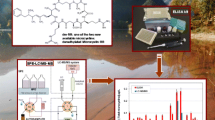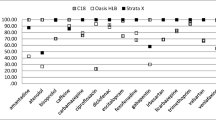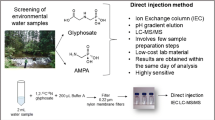Abstract
The presence of acrylamide in natural systems is of concern from both environmental and health points of view. We developed an accurate and robust analytical procedure (offline solid phase extraction combined with UPLC/MS/MS) with a limit of quantification (20 ng L−1) compatible with toxicity threshold values. The optimized (considering the nature of extraction phases, sampling volumes, and solvent of elution) solid phase extraction (SPE) was validated according to ISO Standard ISO/IEC 17025 on groundwater, surface water, and industrial process water samples. Acrylamide is highly polar, which induces a high variability during the SPE step, therefore requiring the use of C13-labeled acrylamide as an internal standard to guarantee the accuracy and robustness of the method (uncertainty about 25 % (k = 2) at limit of quantification level). The specificity of the method and the stability of acrylamide were studied for these environmental media, and it was shown that the method is suitable for measuring acrylamide in environmental studies.





Similar content being viewed by others
References
Alpmann A, Morlock G (2008) Rapid and sensitive determination of acrylamide in drinking water by planar chromatography and fluorescence detection after derivatization with dansulfinic acid. J Sep Sci 31(1):71–77
Backe WJ, Yingling V, Johnson T (2014) The determination of acrylamide in environmental and drinking waters by large-volume injection—hydrophilic-interaction liquid chromatography and tandem mass spectrometry. J Chromatogr A 1334:72–78
Cavalli S, Polesello S, Saccani G (2004) Determination of acrylamide in drinking water by large-volume direct injection and ion-exclusion chromatography-mass spectrometry. J Chromatogr A 1039(1–2):155–159
Chu S, Metcalfe CD (2007) Analysis of acrylamide in water using a coevaporation preparative step and isotope dilution liquid chromatography tandem mass spectrometry. Anal Chem 79(13):5093–5096. doi:10.1021/ac0623179
DeArmond PD, DiGoregorio AL (2013) Characterization of liquid chromatography-tandem mass spectrometry method for the determination of acrylamide in complex environmental samples. Anal Bioanal Chem 405(12):4159–4166
European Council (1998) Directive 98/83/EC of 3 November 1998 on the quality of water intended for human consumption. Off. J. Eur. Commun. L330. European Union Brussels
European Standard (2001) EN 13130–10 Materials and articles in contact with foodstuffs. Part 10: determination of acrylamide in food simulants. Brussels, Belgium
European Parliament, European Council (2006) Registration, Evaluation, Authorisation and Restriction of Chemicals (REACH), establishing a European Chemicals Agency. No 1907/2006
Guézennec AG, Michel C, Desroche N, Togola A, Touzé S. Microbial aerobic and anaerobic degradation of acrylamide in sludges and industrial and natural waters—sand and gravel quarry case study. Environmental Science and Pollution Research in press
Kawata K, Ibaraki T, Tanabe A, Yagoh H, Shinoda A, Suzuki H, Yasuhara A (2001) Gas chromatographic-mass spectrometric determination of hydrophilic compounds in environmental water by solid-phase extraction with activated carbon fiber felt. J Chromatogr A 911(1):75–83
Marin JM, Pozo OJ, Sancho JV, Pitarch E, Lopez FJ, Hernandez F (2006) Study of different atmospheric-pressure interfaces for LC-MS/MS determination of acrylamide in water at sub-ppb levels. J Mass Spectrom 41(8)
Simpson NJK (2000) Solid-phase extraction principles, techniques, and applications. CRC Press edn, Taylor and Francis
Touzé S, Guérin V, Togola A, Guézennec AG, Binet S, Adam Y Dissemination of acrylamide monomer from polyacrylamide based flocculant use—sand and gravel quarry case study. Environmental Science and Pollution Research in press
US Environmental Protection Agency (1985) Health and environmental effects profile for acrylamide. Office of Research and Development, Washington, D.C.
US Environmental Protection Agency (1994) Acrylamide, acrylonitrile and acrolein by high performance liquid chromatography. Method 8316. Cincinnati, USA
US Environmental Protection Agency (1996) Acrylamide by gas chromatography, scope and application. Method 8032A. Cincinnati, USA
US Environmental Protection Agency (2002) National primary drinking water regulation. Washington DC
Weideborg M, Kallqvist T, Odegard KE, Sverdrup LE, Vik EA (2001) Environmental risk assessment of acrylamide and methylolacrylamide from a grouting agent used in the tunnel construction of Romeriksporten, Norway. Water Res 35(11):2645–2652
WHO (2011) Acrylamide in drinking-water. Background document for development of WHO guidelines for drinking-water quality. vol WHO/SDE/WSH/03.04/71/rev1, WHO edn.
Xu LH, Qiao XG, Ma Y, Zhang X, Xu ZX (2013) Preparation of a hydrophilic molecularly imprinted polymer and its application in solid-phase extraction to determine of trace acrylamide in foods coupled with high-performance liquid chromatography. Food Anal Methods 6(3):838–844
Acknowledgments
This work was funded by the French National Research Agency (ANR) through the AQUAPOL project (ANR-2010-CESA-019-03).
Author information
Authors and Affiliations
Corresponding author
Additional information
Responsible editor: Philippe Garrigues
Rights and permissions
About this article
Cite this article
Togola, A., Coureau, C., Guezennec, AG. et al. A sensitive analytical procedure for monitoring acrylamide in environmental water samples by offline SPE–UPLC/MS/MS. Environ Sci Pollut Res 22, 6407–6413 (2015). https://doi.org/10.1007/s11356-014-3900-x
Received:
Accepted:
Published:
Issue Date:
DOI: https://doi.org/10.1007/s11356-014-3900-x




